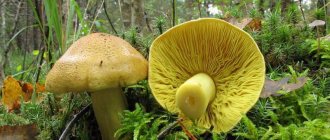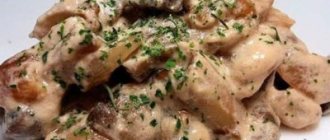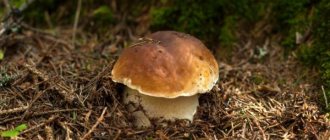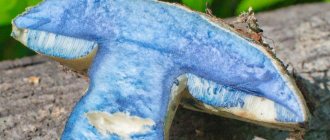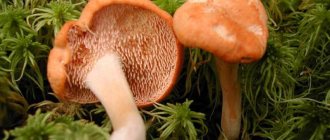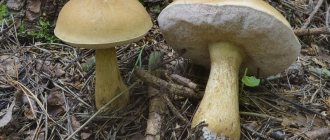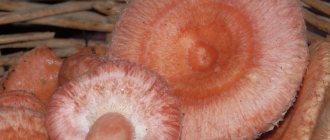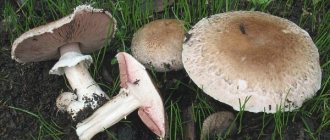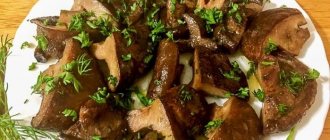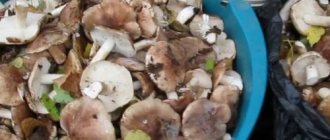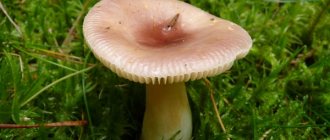May is a great season to try yourself as a mushroom picker. Not many people know that it is in this month that you can find many fruits of such a useful species as the May row. This small fruit is widely used in cooking and contains a lot of useful substances. By getting to know the nature of this plant better, you can discover many new interesting facts.
Where do May rows grow?
The first spring mushroom grows in the western part of the country, in the Urals and the Far East, in Siberia, preferring to settle in mixed forests, parks and groves, along the edges of country roads. You can also find it in the city - on lawns or flower beds, among flowers and herbaceous perennials, as well as in private gardens. The habitats of the May row are sunny and open - pastures, meadows, sparse thickets of bushes. She prefers sandy soil in birch and pine groves, choosing loose grassy litter for herself. Active fruiting time occurs in late spring and early summer. In September, the rows can be found in the same places where they grew in the spring, but in small quantities. Rowing is also growing in all European countries. It can often be found in places where morels and stitches grow.
Spreading
A common species in the European territory of the Russian Federation. Grows everywhere: roadsides, pastures, forest edges, fields, vegetable gardens, orchards, parks, flower beds, groves, forests, meadows. Its distribution is completely independent of the type of forest and soil. The mushroom grows in clusters, so-called “witch rings,” but single specimens are also quite common. Just by the name you can tell that the peak hunting season for this mushroom is in May. The fruiting period lasts until June-July.
What May rows look like
May row (other names - May mushroom, May kalocybe, Calocybe gambosa) is a lamellar mushroom, which is characterized by a white color with a creamy tint, a fleshy cap and a dense cylindrical or club-shaped leg.
The diameter of the cap is from 5 to 12 cm, its shape is flattened or convex-spread, with uneven, as if cracked, edges. With age, the cap acquires a yellow-ocher color, but the plates of both old and young specimens have a light, whitish-cream color. At the same time, in overgrown mushrooms, the plates become thinner and become more frequent. In some fruiting bodies, the cap bends during growth, which is associated with the biological features of the structure.
The shortened, dense leg does not grow more than 9 cm in height, expanding downward. Its maximum thickness is 3.5 cm. The color of the leg is white with a yellowish tint, becoming ocher-yellow closer to the base. The pulp of the May row is dense and fleshy, white in color, and when cut it exudes a strong, pleasant aroma of flour. The taste is also mealy and fresh. When cut, the pulp does not change color. In appearance, representatives of this variety are somewhat reminiscent of champignons. However, a detailed description and photo of mushrooms makes it easy to distinguish the May row from other representatives of the mushroom kingdom.
Similar species
The brown row mushroom is harmless. But if you don’t know its distinctive features well enough, you can easily confuse the specimen with other similar and sometimes dangerous types of rowing.
- Yellow-brown. It has yellow flesh and yellow-brown plates. The fungus forms mycorrhiza with birch. This specimen cannot be found in coniferous forests. It belongs to the edible and safe representatives of the kingdom, but at the same time, it is considered very tasteless. Avid mushroom pickers never collect it.
- Spotted. If stains are found on the cap, you need to be wary. The specimen is classified as low-poisonous, but at the same time poses a danger to humans. The spots are arranged in circles or dark and wide stripes. The pulp is bitter. It grows both singly and in families. It can be extremely difficult to distinguish a mushroom from the original. The main difference is the absence of a clear color transition on the stem. Also, the characteristic bitterness of the pulp should cause suspicion.
- Broken. The main difference is a thin, film-like ring that is slimy to the touch. It is located under the cap. You need to focus on the place where the brown shade of the leg turns into light. The taste of the pulp is bitter, but the specimen is safe and can be used as food.
- Poplar. It does not grow in forests - this is the main difference from the original mushroom. In appearance, the mushroom is larger and fleshier. The specimen is safe and is used in cooking quite often.
- Golden. It has a bright golden-orange hue. The entire area is covered with small scales. Edibility is very conditional. According to some reports, it contains a strong poison similar to muscarine. It belongs to the conditionally edible specimens, but is not valued by mushroom pickers.
Carefully inspect all collected mushrooms. Don’t be greedy and feel free to get rid of suspicious specimens.
The taste of the May row
May row, which in European countries is called St. George's mushroom, has the taste and aroma of fresh flour with pleasant cucumber notes. It is not eaten in its raw form, but it is excellent for winter preparations and preparing various culinary dishes. Ryadovka exhibits its taste properties best when fried. Pickled and salted fruit bodies also reveal their flavor well. However, true gourmets use them in the preparation of soups, sauces, and broths. For winter consumption they are dried and frozen.
Places of growth
The generic name of the gray row is Tricholoma. This group includes many species, including poisonous and conditionally edible. There are also edible and inedible, and the second group is not toxic to humans, but has no nutritional value. Thus, all varieties of tricholoma are divided into 4 groups. From the point of view of botanists, Ryadovka is a lamellar above-ground mushroom, the genus is Agaricaceae, the family is Ryadovka or Tricholomaceae.
Svinushka mushroom: main varieties
The distribution area of the fungus is in places with a temperate climate, located in the Northern Hemisphere. As a rule, rows are mycorrhiza-formers. During their life, they form mycorrhizae on tree roots. Plants with which Tricholoma is in symbiosis:
- fir;
- beech;
- oak;
- larch;
- spruce;
- birch.
Benefits and harm to the body
Culinary dishes from the May row are not only tasty, but also extremely beneficial for the human body, because the main product has a lot of medicinal properties. Scientific research has proven that Kalocybe is capable of:
- remove toxins and waste from the body;
- stimulate the restoration of liver cells;
- normalize the tone of the stomach and intestines;
- increase immunity.
They contain vitamins A, C, PP, B, various microelements, and most importantly, enzymes from which antibiotics are obtained in the medical industry to destroy the tuberculosis bacillus. Due to their chemical composition, rows have unique properties:
- antibacterial;
- antiviral;
- anti-inflammatory;
- antioxidant.
Mushrooms contain a minimal amount of calories and have a balanced composition, which allows them to be widely used for dietary and vegetarian nutrition. In their composition, they are close to such a valuable product as beef liver and successfully replace meat.
In official medicine, it is recommended to eat May row for those who suffer from:
- nervous disorders;
- diabetes mellitus;
- hypertension;
- oncological diseases;
- disorders of the genitourinary system;
- osteoporosis;
- rheumatism;
- arrhythmia and other cardiovascular diseases.
White May row helps prevent colds. If the product is regularly included in the weekly menu for three months, then during the epidemic season it is possible to completely avoid infection. One of the most valuable properties of kalocybe is the presence of anti-cancer components in its composition. Therefore, in China, a medicine against ovarian and cervical cancer is prepared from this species, and in Russia, extracts from the pulp are used to make medicines against diabetes.
No harm has been identified from consuming May row. However, like other mushrooms, it is a rather heavy food that is not recommended to be abused. Dishes with kalocybe are completely contraindicated for gastritis with low acidity, pancreatitis and chronic diseases of the gastrointestinal organs in the acute stage.
Important! Caps and very young specimens are easier on the stomach and digestion. Children under 3 years old should not eat mushrooms in any form.
Common myths about poisonous mushrooms
Signs of a wormy mushroom
There are many well-established misconceptions about poisonous mushrooms, as well as folk methods for testing their edibility. For example:
- Poisonous mushrooms smell unpleasant. In fact, they can be either odorless or attractive with an aroma reminiscent of edible species.
- To detect a poisonous mushroom, you need to throw an onion into the pan during cooking - its blue color indicates toxins. In fact, onions turn blue due to the presence of a safe enzyme called tyrosinase in the mushroom.
- If you put a silver spoon into a mushroom broth and it turns dark, it means there are poisonous mushrooms. Darkening of the metal occurs due to sulfur, which is present in all types.
- There are no worms in poisonous mushrooms. A serious misconception - any mushroom can be wormy.
- At a young age, there are few toxins in poisonous mushrooms. This is not true, because many of them pose a danger regardless of age and quantity.
How to distinguish May row
May row, which grows in a country house or in a garden, is similar in appearance to the white variety, the cap of which in young specimens is rounded and convex, and becomes flat with age. Poisonous white grass has a pungent taste and a sharp, unpleasant odor. It grows from August to the end of October.
The stinking row is inedible and can cause hallucinations, so it is not eaten. The fruit body has compacted pulp and a convex white cap. Emits a pungent smell of lamp gas. The variety bears fruit in the fall, in September-October. On the territory of Russia it grows only in the Amur region, but in Europe it is found everywhere.
As mentioned above, during the spring harvest, it is impossible to confuse the May mushroom with other members of the family, since they all bear fruit in the fall. However, the May row sometimes appears in September, continuing its growing season. During autumn mushroom hunting, you should pay maximum attention. The main differences between inedible and poisonous rows are an unpleasant, pungent odor and pungent taste. Over time, their caps acquire a flat shape, which is not typical for May calocybe.
Chemical composition
May mushroom contains a large amount of vitamins:
- a nicotinic acid;
- thiamine;
- folic acid;
- riboflavin;
- pantothenic acid;
- vitamins K1, B12, B6, D, D2, C, E;
- betaine;
- folates;
- tocotrienol, alpha;
- choline;
- tocopherol, beta, gamma, delta.
Minerals:
- Na;
- Fe;
- P;
- Mg;
- Ca;
- Cu;
- K;
- Mn;
- Zn;
The composition of the mushroom is also rich in amino acids and lipids, including glutamic and aspartic acids, which are natural antibiotics. May row also contains dextrose, glucose and glycine.
Collection rules
May rows are collected in spring and early summer, in dry weather. Young and fairly mature specimens are selected, cutting off at the base with a sharp knife. Unlike autumn representatives, May mushrooms do not accumulate toxins, so even adult fruiting bodies can be safely used as food. The harvest time coincides with the active fruiting of morels and strings, which allows mushroom pickers to return home from the forest with a rich harvest. Since the variety grows in the spring-summer period, when most of the mushrooms have not yet begun to bear fruit, it is impossible to confuse it with similar species. Finding a May row is not difficult; mushrooms grow in large groups, dense rows and “witch” circles, as shown in the photo, and if the search is successful, the basket will quickly fill with dense, fragrant fruiting bodies.
Contraindications
Contraindications include problems with the gastrointestinal tract present in a person: colitis, gastritis, ulcers, cholecystitis, pancreatitis.
During pregnancy, mushrooms are allowed to be consumed only in small quantities and only in stewed or boiled form to avoid diarrhea, heartburn and nausea.
Children should also use mushrooms with caution - it is still difficult for a child’s digestive system to cope with such a product due to its physiological immaturity.
There are some contraindications to the use of the mushroom
How long to cook May row
The collected mushrooms are first sorted out, cleared of debris and washed thoroughly. Soak for 2 hours to remove any remaining dirt. Before you start preparing culinary dishes from the May row, the raw materials must be properly prepared. In order for the taste qualities of the product to be fully revealed, the fruiting bodies are subjected to preliminary complex heat treatment.
Algorithm of actions:
- Boil the mushrooms for 10 minutes. in a large amount of water with the addition of table vinegar.
- The liquid is changed by filling the kalocybe with fresh water, also adding vinegar.
- Boil for 20 minutes, then add a head of peeled onion and boil for another 10 minutes.
- Place in a colander, pour out the broth, and prepare the rows according to the recipe used.
Important! This complex processing makes it possible to eliminate the bitterness and unpleasant mealy taste from mushrooms. You can get rid of bitterness in another way - soak the fruiting bodies with the skin removed from the cap for 12 - 15 hours in salt water.
How to prepare May row
Recipes for dishes from the May row are varied. Mushrooms are great for pickling, stewing, frying, and pickling. The fruiting bodies pre-prepared in the above manner are placed in a heated frying pan with butter, salt, pepper, and onion rings are added. According to many gourmets, this is the most savory dish made from kalocybe. This species also reveals its original taste and forest, unusually pleasant aroma in soups and sauces with the addition of sour cream and butter.
The following recipe for pickling May row will allow you to prepare it for winter storage.
The algorithm of actions is as follows:
- Pre-boiled fruiting bodies are placed in an enamel pan and filled with water.
- For 1 kg of mushrooms take 30 g of salt and sugar, 2 bay leaves, several buds of cloves and black peppercorns. Everything is sent to the mushroom mass.
- After boiling, cook for 5 minutes. and add 40 ml of vinegar.
- The mixture is distributed into sterilized jars, peeled garlic cloves are added and 1 - 2 tbsp on top. l. vegetable oil.
- The jars are sealed and stored in a cool, dark place.
Salted rows are prepared in a slightly different way:
- The prepared fruiting bodies are placed in an enamel pan in layers, each sprinkled with salt, peppercorns, and horseradish leaves. Add peeled garlic cloves.
- Cover with clean gauze and apply pressure.
- Place in a cool, dark place for 40 days.
- Transfer the salted rows into clean jars and cover with plastic lids.
- Sent to the refrigerator for storage.
Important! Homemade mushroom preparations are stored for no more than 12 months from the date of their preparation.
Kalocybe can also be prepared for future use by drying, for which the fruiting bodies are strung on a thread and hung in a well-ventilated, sunny and open place. The drying process lasts 40 days.
In addition, May rows, previously boiled in salted water, can be placed in the freezer and subsequently prepared from them any mushroom dishes.
Cooking recipes + photos
Having learned how to prepare the May row correctly, every mushroom picker will be able to enjoy delicious dishes, despite the unusual taste and aroma of the fruit. Time-tested recipes will highlight the advantages of forest gifts, making the disadvantages less pronounced.
To prepare St. George's mushroom, you first need to thoroughly rinse the fruits under running water and soak in a salted solution for 30-40 minutes. Then, the row is first boiled, draining the mushroom broth. And further preparation depends on the choice of dish. If you want to get a winter preparation, salting or pickling is suggested. If a person prefers a fried product, mushrooms are prepared as a separate dish or as an ingredient for a stir-fry, soup or warm salad.
Important!
To remove unpleasant odor and taste, initial boiling is recommended, followed by draining the infusion and rinsing under running water. If desired, you can add ground black pepper, paprika and dried herbs to improve the taste. Good seasonings that dull the main aroma are cinnamon and cloves. If possible, you can add a pinch of ground ingredient. The main thing is not to overdo it!
First recipe - May row in French
This recipe has become popular in recent years among most cooks. Despite the name, it does not resemble French meat. Mushrooms are prepared with the addition of butter, meat broth, ham and croutons. The hot dish is served both as a first and second course, depending on what the household prefers. For example, if it is customary to serve soup or borscht as a first course, French-style May row will become the second course.
Ingredients for cooking:
- 1 kg of fresh mushrooms;
- 0.5 liters of white semi-sweet wine (table wine is an alternative);
- 250 g butter;
- 550 ml pork or chicken broth;
- 550 g ham;
- croutons to taste.
Step by step recipe:
1) Preparation should begin with primary heat treatment, sautéing and chopping the mushrooms in the form of long sticks.
2) Next, the May row is stewed in chicken broth and wine.
3) The ham is fried in a separate frying pan and added to the main dish being prepared next to it.
4) The finished dish is laid out on plates and sprinkled with croutons.
Recipe with the addition of feta cheese
Gourmets will surely love a recipe that includes cheese in its preparation. Homemade cheese will make the dish more tender, tasty, aromatic and healthy.
Products for cooking:
- 500 g mushrooms;
- 2 eggs;
- 300 g feta cheese;
- 100 g butter;
- salt, spices and pepper - to taste.
Step-by-step preparation
The dish is prepared in a simplified manner. In order to obtain mushrooms under cheese, after heat treatment and boiling, the product is washed under running water and dried. The row is cut into small pieces and fried in a frying pan, adding the necessary spices and salt. 5-7 minutes before readiness, break eggs on top and wait for readiness. Once the dish is ready, grate cheese over the eggs and cover with a lid. After 5 minutes, the dish is served to the table, sprinkled with fresh herbs.
